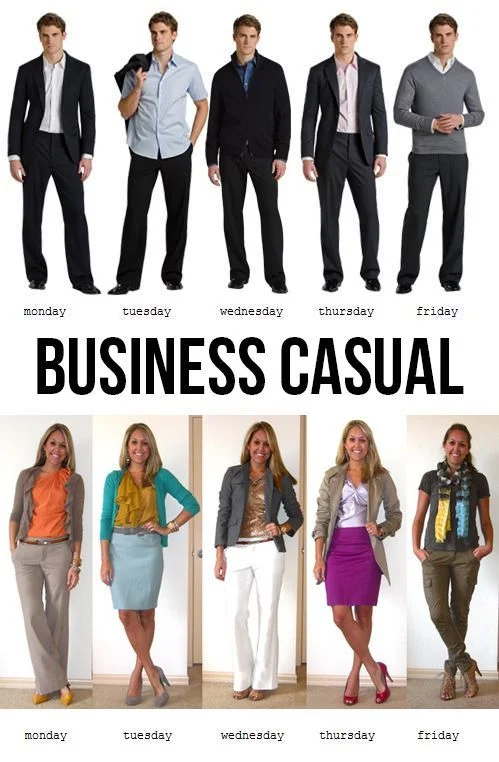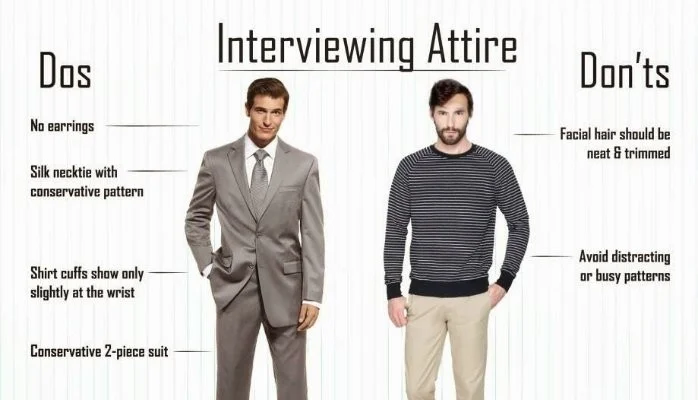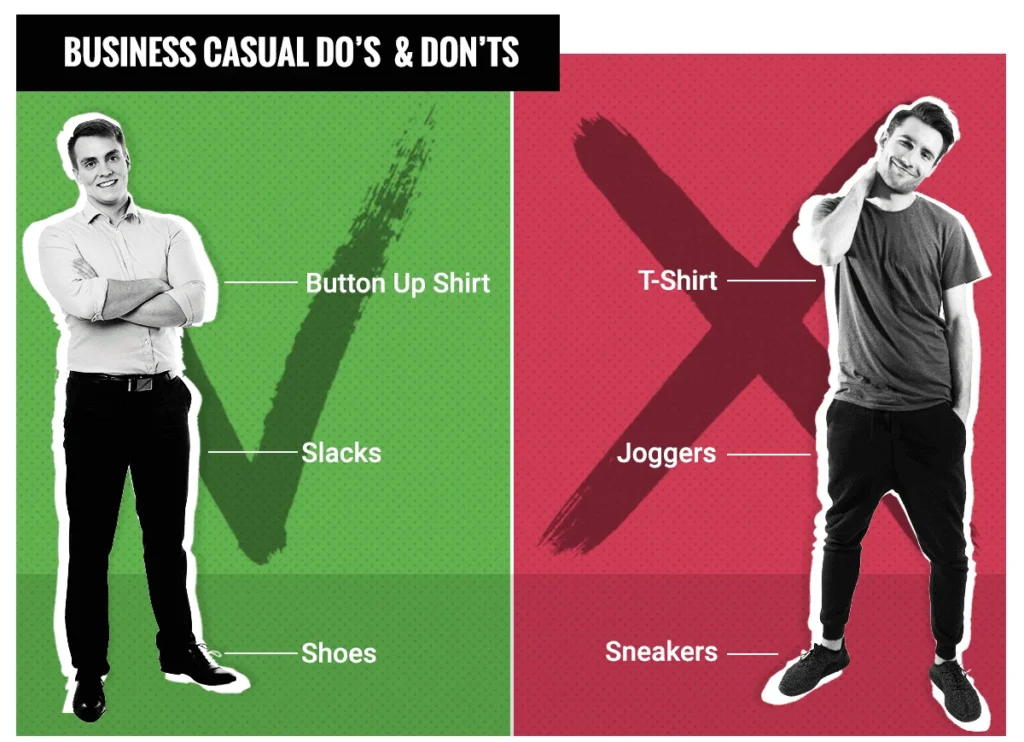I. Introduction
Imagine entering a crucial business meeting only to realize you’re the most underdressed person in the room. The discomfort and distraction from this small detail can derail even the best presentation. Did you know that 55% of first impressions are made by what we see, including clothing? In this blog, you’ll learn the ins and outs of business casual attire, ensuring you’re always dressed appropriately and confidently for any professional setting.
Brief Overview: Business casual attire has become the standard dress code in many modern workplaces, balancing professionalism and comfort. Understanding how to navigate this dress code is essential for making a positive impression, feeling confident, and performing your best at work. Whether you’re preparing for a job interview, attending a client meeting, or simply dressing for a day at the office, mastering business casual attire is a valuable skill in today’s professional world.

II. What is Business Casual?
Definition and Origins: Business casual is a dress code that combines traditional business wear with a more relaxed style. It strikes a balance between formal business attire, such as suits and ties, and the casual comfort of everyday clothing. Business casual typically includes items like slacks, khakis, blouses, polo shirts, and blazers, but excludes jeans, sneakers, and overly casual garments.
The concept of business casual originated in the 1960s in Silicon Valley, where tech companies sought to create a more relaxed and innovative work environment. The trend gained momentum in the 1990s with the rise of “Casual Fridays,” where companies allowed employees to dress down at the end of the workweek. This shift reflected a broader move towards more flexible and comfortable workplace norms, ultimately leading to the widespread adoption of business casual dress codes.
III. Key Elements of Business Casual:
For Men:
- Shirts: Collared shirts, polo shirts, or dress shirts. Ties are optional.
- Pants: Slacks, chinos, or khakis. Avoid jeans and overly casual pants.
- Jackets: Blazers or sports coats can add a professional touch.
- Shoes: Loafers, oxfords, or other leather shoes. Sneakers and sandals are not appropriate.
- Accessories: Minimalistic and professional. Belts should match shoes.
For Women:
- Tops: Blouses, button-down shirts, or knit tops. Avoid overly revealing or casual tops.
- Bottoms: Slacks, tailored pants, or skirts that are knee-length or longer. Avoid denim and overly casual skirts.
- Dresses: Business-appropriate dresses that are not too tight or short.
- Shoes: Flats, loafers, low-to-mid heels. Avoid overly casual shoes like flip-flops.
- Accessories: Professional and understated. Jewelry should be minimal.
Variations Depending on Industry and Company Culture:
- Tech Industry: Often more relaxed, with options like nice jeans and casual button-down shirts being acceptable.
- Finance and Law: Generally more conservative, requiring slacks, blazers, and more formal footwear.
- Creative Industries (e.g., Marketing, Advertising): Typically allow for more personal expression and stylish choices within the business casual framework.
- Corporate Settings: Often follow stricter guidelines, with an emphasis on polished and professional looks.
Understanding the specific expectations of your industry and company culture is crucial for navigating business casual attire successfully. Always consider the environment and your role within the organization to ensure you’re dressed appropriately.

IV. Why Business Casual Matters?
Professional Image: Business casual attire plays a pivotal role in shaping one’s professional image. Dressing appropriately in a business casual setting demonstrates an understanding of workplace norms and shows respect for the professional environment. Fashion consultant Jill Greenberg notes, “Business casual allows individuals to present themselves as competent and approachable. It strikes the right balance between being too formal and too casual, making it easier to build rapport with colleagues and clients.”
HR professionals often emphasize the importance of dressing for the role you aspire to. Sarah Johnson, an HR manager at a Fortune 500 company, explains, “Employees who adhere to business casual dress codes are often perceived as more reliable and capable. It’s not just about the clothes themselves, but the effort and attention to detail that communicate dedication and professionalism.”
Comfort and Productivity: Finding the balance between comfort and maintaining a professional appearance is crucial for both personal well-being and productivity. Comfortable clothing can significantly impact how employees feel and perform at work. A study conducted by the American Psychological Association found that employees who dress comfortably yet professionally report higher levels of job satisfaction and productivity.
Business casual attire provides the flexibility to choose clothes that are both suitable for the office and comfortable for extended wear. This balance is essential in environments where employees may need to transition between different tasks or settings throughout the day. Fashion consultant Emily Taylor highlights, “When employees are comfortable, they’re less distracted by physical discomfort and more focused on their tasks. This can lead to higher productivity and better overall job performance.”
Surveys have shown that employees appreciate the flexibility that business casual dress codes offer. According to a survey by OfficeTeam, 56% of employees believe that a business casual dress code positively impacts their productivity. Additionally, 79% of workers feel that they perform better when they are dressed comfortably.
In summary, business casual attire enhances one’s professional image by striking the right balance between formality and approachability. It also boosts comfort and productivity, leading to a more satisfied and effective workforce. By understanding and embracing business casual dress codes, employees can navigate their professional environments with confidence and ease.
V. Building Your Business Casual Wardrobe
Essential Pieces for Men:
- Chinos:
- A staple in any business casual wardrobe, chinos offer comfort and versatility. Opt for neutral colors like khaki, navy, and gray for maximum flexibility.
- Mix and Match Tip: Pair chinos with a variety of shirts, from button-downs to polo shirts, and add a blazer for a more polished look.
- Button-Down Shirts:
- Crisp, well-fitted button-down shirts in solid colors or subtle patterns are essential. White, light blue and checkered patterns are classic choices.
- Mix and Match Tip: Button-down shirts can be worn tucked in with chinos or slacks for a sharp appearance. Roll up the sleeves for a more relaxed, yet still professional, look.
- Blazers:
- A well-tailored blazer instantly elevates any outfit. Navy and gray blazers are versatile and can be paired with various pants and shirts.
- Mix and Match Tip: Layer a blazer over a button-down shirt and chinos for meetings or presentations. It can also be worn over a sweater for a smart casual look in cooler weather.
- Loafers:
- Comfortable and stylish, loafers are the perfect footwear for business casual attire. Choose leather loafers in black, brown, or burgundy.
- Mix and Match Tip: Loafers can be worn with or without socks, depending on the formality of the occasion. They pair well with both chinos and dress pants.
Essential Pieces for Women:
- Blouses:
- A collection of blouses in various colors and patterns is a must. Opt for materials like silk, cotton, and polyester for a polished look.
- Fashion Expert Advice: “Choose blouses with interesting details like ruffles or subtle prints to add personality to your outfit while maintaining professionalism,” suggests fashion stylist Anna Wintour.
- Tailored Pants:
- Tailored pants in neutral colors such as black, navy, and gray are essential. Look for high-quality fabrics that drape well.
- Fashion Expert Advice: “Invest in a few pairs of tailored pants that fit well and can be easily dressed up or down,” advises designer Rachel Zoe. “Pair them with blouses or sweaters for a versatile wardrobe.”
- Skirts:
- Knee-length skirts in classic cuts like pencil or A-line are ideal for a business casual wardrobe. Stick to neutral colors and simple patterns.
- Fashion Expert Advice: “A well-fitted skirt can be a versatile piece that transitions from day to night. Choose skirts that are comfortable and professional,” recommends fashion editor Nina Garcia.
- Flats:
- Flats are a comfortable and stylish footwear option for women. Ballet flats, loafers, and low-heeled shoes in neutral colors are versatile choices.
- Fashion Expert Advice: “Flats can be both comfortable and chic. Look for pairs with cushioned insoles for all-day wear,” suggests footwear designer Sarah Flint.

Seasonal Adjustments:
- Spring/Summer:
- Light fabrics like cotton and linen are ideal for warmer weather. Men can opt for short-sleeve button-downs and lighter-colored chinos, while women can choose lightweight blouses and skirts.
- Industry Standard Tip: “During warmer months, it’s important to stay cool while maintaining a professional appearance. Choose breathable fabrics and lighter colors,” advises corporate style consultant John Doe.
- Fall/Winter:
- Layering is key for colder weather. Men can add sweaters or vests under blazers, while women can wear cardigans or tailored coats. Darker colors and heavier fabrics like wool are suitable for the season.
- Industry Standard Tip: “Incorporate layers to stay warm without compromising on style. Choose pieces that can be easily removed or added as needed,” recommends fashion industry veteran Jane Smith.
Building a business casual wardrobe with these essential pieces ensures you are always prepared for any professional setting. By following authoritative tips and expert advice, you can create versatile and stylish outfits that suit any season.

VI. Common Mistakes and How to Avoid Them
Dos and Don’ts
Common Mistakes:
- Wearing Jeans:
- Don’t: Jeans, even when clean and stylish, often don’t fit the business casual criteria for many workplaces. They can be too casual for certain professional settings.
- Do: Opt for chinos or tailored pants in neutral colors. These provide a more polished and versatile look.
- Overdressing or Underdressing:
- Don’t: Wearing overly formal items like a suit jacket or dress shoes, or conversely, dressing too casually in sweatpants or graphic tees, can disrupt the intended business casual vibe.
- Do: Find a middle ground. Pair a blazer with chinos and a button-down shirt for a balanced appearance.
- Ignoring Fit:
- Don’t: Clothes that are too tight or too loose can appear unprofessional and uncomfortable.
- Do: Invest in well-fitting garments. Tailoring can help ensure that your clothes fit correctly, enhancing both comfort and appearance.
- Neglecting Grooming:
- Don’t: Overlook personal grooming. Untidy hair, unkempt facial hair, and worn-out shoes can undermine a business casual outfit.
- Do: Maintain a neat appearance with regular grooming and well-cared-for accessories. Ensure shoes are polished and clothing is free from wrinkles.
- Overdoing Accessories:
- Don’t: Wearing too many accessories or flashy items can be distracting and unprofessional.
- Do: Keep accessories minimal and tasteful. A simple watch or subtle jewelry is often sufficient.

Real-Life Examples
- Testimonial from a Professional:
- Emma Roberts, Marketing Manager: “When I first started at my company, I wore jeans and sneakers thinking they were business casual enough. I quickly learned that my choice was too casual for client meetings. Switching to chinos and loafers made a huge difference in how I was perceived. It’s all about finding that balance and being mindful of the company’s culture.”
- Case Study – Google:
- Google is known for its relaxed office environment, but employees still adhere to a business casual dress code. A case study from Business Insider highlighted that employees who embraced a smart casual approach, like pairing a neat polo shirt with chinos, performed better in client-facing roles, as they balanced comfort with a professional image.
- Case Study – IBM:
- At IBM, a shift from traditional business attire to business casual was implemented to foster a more innovative and approachable work environment. According to a report by the Harvard Business Review, employees who embraced business casual attire reported feeling more confident and engaged in their work. This shift allowed for greater self-expression while maintaining a professional appearance.
By understanding and avoiding common mistakes in business casual attire, professionals can enhance their appearance and align with workplace expectations. Real-life testimonials and case studies from industry leaders illustrate the importance of balancing comfort and professionalism to achieve success in various work environments.








Every weekend i used to visit this website, as i want enjoyment,for the reason tgat this this website conatios actually good funny stuff too. https://Odessaforum.biz.ua/
Pingback: Are Jeans Business Casual? Your Guide to Modern Office Wear